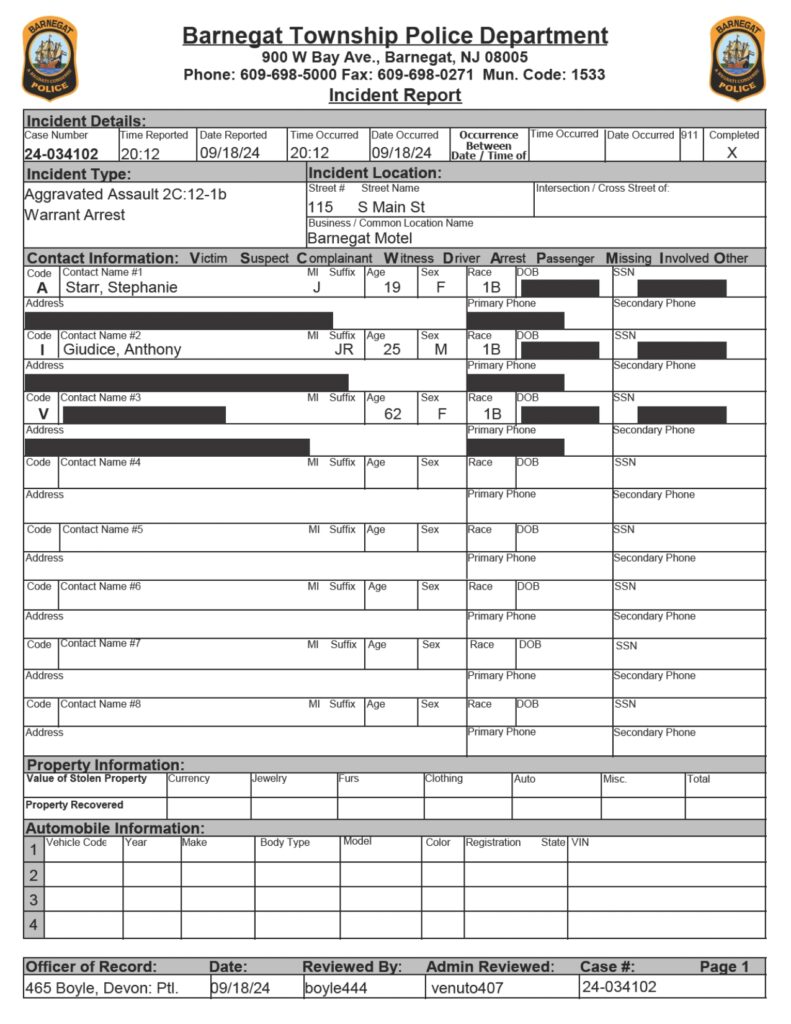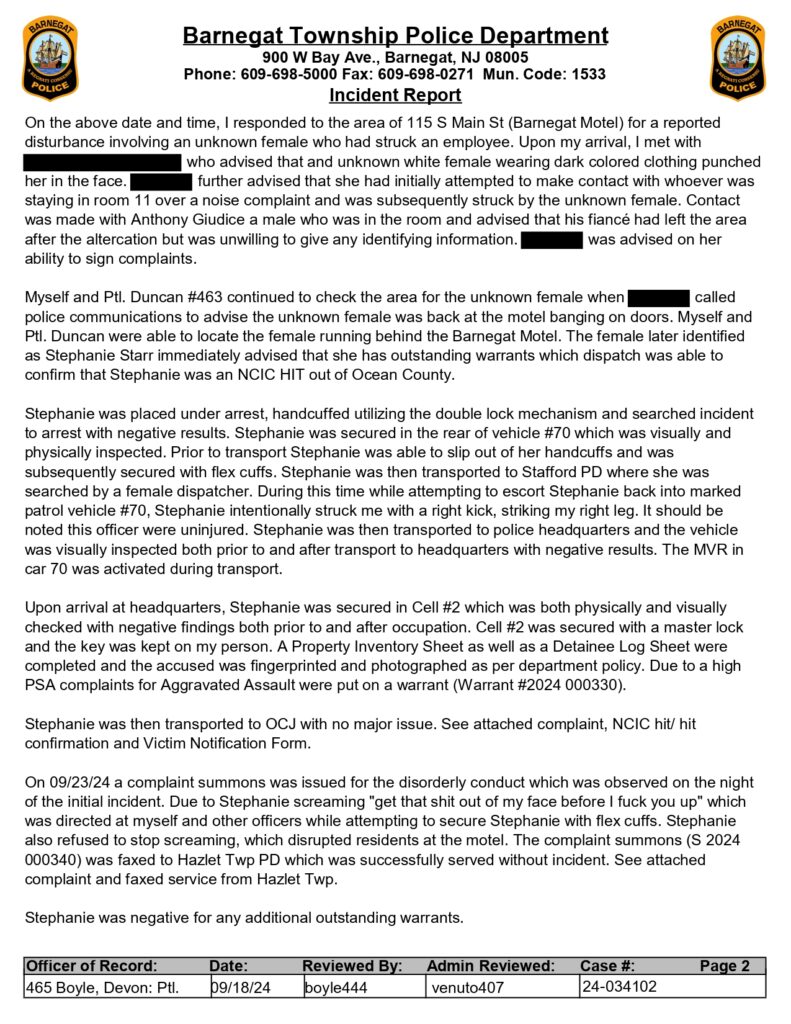A late-night noise complaint at the Barnegat Motel spiraled into a dramatic arrest, exposing issues of mental distress, outstanding warrants, and an assault on a police officer. The entire incident was captured on body camera, providing a raw, unfiltered look into the challenges law enforcement faces.
If you’ve seen the viral video and want to understand the full story behind the chaos, this article breaks down the official police reports, the body cam transcript, and offers an analysis of the events.
Watch the Full Body Cam Footage Here: [Insert Your YouTube Video Link]
Access the Redacted Police Report: [Link to the report file, if hosted online]
Table of Contents
The Incident at a Glance: What Happened?
On September 18, 2024, at approximately 8:12 PM, officers from the Barnegat Township Police Department responded to the Barnegat Motel at 115 S Main St. for a reported disturbance. The situation involved multiple layers:
- The Initial Assault: A motel employee reported being punched in the face by an unknown woman later identified as Stephanie Starr (19). The altercation began when the employee went to Room 11 to address a noise complaint.
- The Search: Officers spoke with Stephanie’s fiancé, Anthony Giudice (25), who was uncooperative and refused to provide Stephanie’s identifying information. He stated she had “mental issues” and had left the area.
- The Arrest: While officers were searching, they were notified that the woman was back, banging on doors. They located Stephanie Starr running behind the motel. Upon contact, Stephanie immediately volunteered that she had outstanding warrants, which dispatch confirmed.
- The Escalation: After being arrested and placed in a patrol car, Stephanie managed to slip out of her handcuffs. She was re-secured with flex-cuffs. Later, while being escorted at the Stafford Police Department, she intentionally kicked the arresting officer in the leg.
- Additional Charges: Due to her aggressive behavior at the scene—including screaming threats like, “get that shit out of my face before I fuck you up” at officers—a separate complaint summons for Disorderly Conduct was issued days later.
A Deeper Dive: Key Moments from the Body Camera Transcript
The transcript reveals the tense and often chaotic interaction between Stephanie, her fiancé, and the police.
- The Uncooperative Fiancé: Anthony Giudice is evasive from the start. He initially claims not to know “the other girl,” then later identifies her as his fiancée. He repeatedly refuses to give her name, hinting he knows about her warrants, telling officers, “I know how the game works.”
- Stephanie’s Immediate Confession: The moment she is found, Stephanie doesn’t hesitate. She tells the officers, “I have a warrant,” and later clarifies, “I have a warrant from her… It’s for a failure to appear.” This indicates she was aware of her legal situation.
- Mental State and Distress: Throughout the ordeal, Stephanie is highly emotional, screaming, crying, and making erratic statements. She references her struggles with alcohol addiction, a “cheating ass boyfriend,” and her desire for a “happy and healthy family.” Officers can be heard trying to calm her, with one noting, “I’m sure you’re pretty cool, girl when you’re sober.”
- The Assault on an Officer: The kick was not a fleeting moment of resistance. The transcript shows a pattern of physical non-compliance, culminating in the deliberate kick during a transfer.
- Processing at Headquarters: The transcript details the booking process, including fingerprinting and photographing, during which Stephanie continues to be verbally combative and makes inappropriate comments to the officers.
Writer’s Analysis & Opinion: Did Police Handle This Correctly?
Based on the evidence from the report and the transcript, here is an analysis of the police department’s handling of the situation:
What Was Done Well:
- Patience and De-escalation Attempts: The officers showed considerable patience, especially with Anthony Giudice. They repeatedly explained the situation and tried to reason with him rather than immediately escalating to threats.
- Professionalism During Arrest: Despite Stephanie’s volatile behavior and profanity-laced insults, the officers remained largely professional. They used appropriate restraint techniques (double-locking handcuffs, switching to flex-cuffs after she escaped) and documented everything meticulously.
- Concern for Well-being: The officers took Anthony’s comment about Stephanie’s “mental issues” seriously. They expressed concern for her safety after she ran into the woods, framing their search as a welfare check.
- Thorough Documentation: The report is detailed, and the officers ensured all procedures were followed—from vehicle inspections to cell checks and proper evidence logging. The activation of the Body Worn Camera and MVR (Mobile Video Recorder) was crucial for transparency.
Areas for Scrutiny or Potential Improvement:
- The “Germaphobe” Interaction: During fingerprinting, an officer removes his glove to hold Stephanie’s hand. While likely an attempt to build rapport or calm her, this ungloved contact is unorthodox and could be questioned from a safety and protocol perspective.
- Handcuff Failure: The fact that Stephanie was able to slip out of standard handcuffs is concerning. While the officers rectified it quickly with flex-cuffs, it highlights a potential risk in the initial restraint technique.
Overall Opinion:
The Barnegat police officers involved in this incident largely handled a very difficult situation correctly and by the book. They faced a non-cooperative witness and a highly unpredictable, combative individual who was a known flight risk. Their primary success was in containing a volatile situation without anyone sustaining serious injury, despite being assaulted.
The real tragedy highlighted here is not police conduct but a systemic one. Stephanie Starr is a 19-year-old clearly struggling with addiction and mental health issues. This incident is less about a single arrest and more about a cycle of failure-to-appear warrants and crises that the justice system is poorly equipped to handle. While the police job was to enforce the law—which they did—one is left wondering if a more robust social and mental health infrastructure could have intervened earlier to prevent this scene at the motel altogether.


